

Fiorenzo di Lorenzo enrolled in the the Arte dei Pittori (Artists’ Guild) at an unknown date between 1463 and 1469 (the dates of the entries before and after his). He served as a prior of Perugia in 1472.
The Triptych of Justice (1475-6) from the the Oratorio di SS Andrea e Bernardino (now in the Galleria Nazionale) was generally attributed to Fiorenzo di Lorenzo until Michael Bury (reference below) discovered a document in the archives of the Confraternita di Sant' Andrea della Giustizia that records its commission from Bartolomeo Caporali and Sante di Apollonio del Celandro. This led to a revision of the works that were attributed to him.
The early work of Francesco Melanzio da Montefalco suggests that he had been a student of Fiorenzo di Lorenzo.
All his securely attributed works are in Perugia.
Galleria Nazionale, Perugia
Miracles of St Bernardino of Siena (1473)
Some scholars believe that Fiorenzo di Lorenzo belonged to the so-called Workshop of 1473, which produced the important panels depicting miracles of St Bernardino of Siena that are now in the Galleria Nazionale. (Follow the links in the page on the Workshop of 1473 for more details).
Madonna della Misericordia (1476)
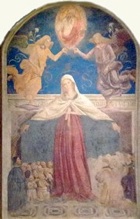
The fresco depicts the Virgin sheltering members of the Collegio della Mercanzia (who owned the hospice) and inmates from the hospice under her cloak. The large figure to the left is probably Canon Galeotti. God the Father looks down as two angels appear to crown the Virgin: it is likely that they originally held a golden crown that has been lost.
Panels from the polyptych of the Sylvestrines (1487-93)
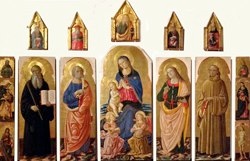
A series of three contracts between the Sylvestrines of Santa Maria Nuova and Fiorenzo di Lorenzo relate to this work:
-
✴The first, dated 1472, documents the commission of a double-sided polyptych.
-
✴The second, dated 1487, reduces the scope of the commission to a single-sided polyptych.
-
✴The third, dated 1491 (when the work seems to have been in progress), requires that the project should be completed by 1493.
This polyptych remained in the church when the Sylvestrines left in 1540. It had almost certainly been originally on the high altar, but it had been moved by the early 17th century. It was probably dismantled in 1810, when it was moved to the Accademia di Belle Arti. It is now in the Galleria Nazionale.
The original frame and the predella panels have been lost.
-
✴The five main panels depict:
-
•the Madonna and Child with two kneeling angels;
-
•St Peter;
-
•St John the Evangelist;
-
•St Benedict; and
-
•a Sylvestrine saint (St Sylvester Gozzolini or the Blessed Paolino Bigazzini, both of whom were included in the agreed scope of the work before it was reduced in 1487).
-
✴The pilasters contain figures of:
-
•a Benedictine monk, the Archangel Gabriel and St John the Baptist (on the left); and
-
•a Benedictine monk, the Virgin Annunciate and St Sebastian (on the right).
-
✴The smaller panels from the upper register contain figures of God the Father and the Doctors of the Church (SS Ambrose, Jerome, Augustine and Gregory).
Niche from San Francesco al Prato (1487)
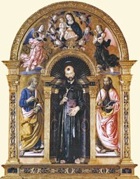
The polygonal niche, which contains an inscription that refers to St Francis as a venerated servant of the Church, is surrounded by painted panels inside a larger Renaissance frame. The panels depict:
-
✴the Madonna and Child in a mandorla of cherubs and two praying angels (above);
-
✴St Peter (to the left); and
-
✴St Paul (to the right).
The signature of Fiorenzo di Lorenzo and the date appear on the hems of the robes of the Apostles.
The predella panel contains small tondi of Franciscan saints:
-
✴St Bonaventure (who had been canonised in 1482, only five years before the panel was painted);
-
✴SS Bernardino of Siena and Antony of Padua; and
-
✴St Louis of Toulouse.
Frescoes from San Nicolò (1498)
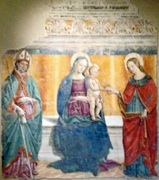
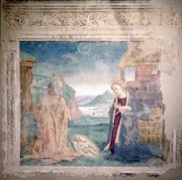
These damaged frescoes, which are dated by inscription and attributed to Fiorenzo di Lorenzo, came from the parish church of San Nicolò, which later became San Giorgio dei Tessitori. They were detached in 1878, just before the church was demolished to make way for the Istituto di Pena Maschile.
The surviving fragments exhibited in Room 24 of the Galleria Nazionale depict:
-
✴the mystic marriage of St Catherine, with St Nicholas of Bari; and
-
✴the Nativity, in which the new born baby Jesus lies naked in a meadow in front of the stable, venerated by the kneeling Virgin and St Josep.
Other fragments in the deposit of the gallery depict figures of SS Sebastian, Francis and John the Baptist.
Panels from a polyptych (late 15th century)
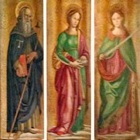
-
✴St Antony Abbot;
-
✴St “Dignamerita”; and
-
✴St Catherine of Alexandria.
The name “Dignamerita” is a reference to the Roman martyrs recorded as SS Digna and Emerita, who were possibly a single person. The figure in this panel holds a fish with a ring in its mouth, for reasons that are now unclear.
Santa Maria di Monteluce
Two works in the church of Santa Maria di Monteluce are attributed to Fiorenzo di Lorenzo:
Crucifixion with saints (late 15th century)
On 7th November 1491, the nuns of Santa Maria di Monteluce made a payment of 9 florins to “Master Fiorenzo” (almost certainly Fiorenzo di Lorenzo) for “the manufacture of a crucifix” in the refectory. The “Memoriale di Santa Maria di Monteluce” refers to the commission of a painting (presumably a fresco) for the refectory, which depicted the crucifixion with the Virgin and SS John the Evangelist, Francis and Clare. It had been financed using money from the will of sister Eufrasia Alfani in the time that Sister Lucy of Foligno was abbess (i.e. before 20th October 1491).
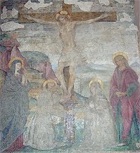
Crucifixion (late 15th century)
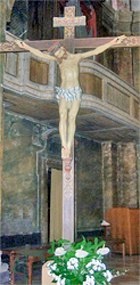
Other Works in Perugia
Fiorenzo di Lorenzo received payment, along with Tiberio d’ Assisi, from the monks of San Pietro in 1504.
Pietà with saints (1469)
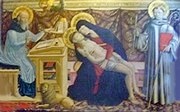
This panel of the Pietà with SS Jerome and Leonard is in San Pietro (at the end of the left aisle). It is undocumented, but used to carry an inscription that identified its date. It used to be attributed to Benedetto Bonfigli, but has been more recently attributed to Fiorenzo di Lorenzo. If the present attribution is correct, it is one of Fiorenzo’s earliest surviving works.
Designs for Palazzo dell' Università Vecchia (1490)
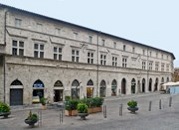
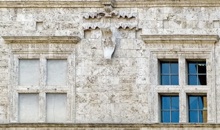
The Confraternita di Santa Maria della Misericordia commissioned Gasparino di Antonio to build this palace (later known as the Palazzo dell' Università Vecchia) as two storeys above the shopping arcade that it had built in Piazza Sopramuro (now Piazza Matteotti). The arms of the hospice appear between the windows above what is now number 32.
Fiorenzo di Lorenzo is documented as having provided designs for the windows in 1490, together with the design for the letters to be used in an inscription. This was presumably the long inscription across the architraves of the 18 windows in the top storey: it is taken from the Gospel of St Matthew (Chapter 25, verse 35 et seq.) and relates to the vocation of the Confraternita della Misercordia: "I was hungry and you gave me food ...".
The construction project proceeded slowly, and the Commune had to supply extra finance in 1512. The complex finally came into use in 1514, at which point the palace presumably passed to the university.
Gonfalon (1494)
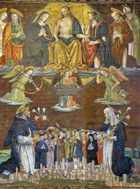
The altarpiece depicts SS Dominic and Catherine of Siena protecting Perugia from the arrows of angels. Above, Christ sits in judgement, flanked by the Virgin and SS John the Baptist, Sebastian, Andrew, Laurence and (probably) Herculanus. Perugia is represented by a group of citizens and a fine cityscape, The female Dominican in prayer, to the left of St Catherine of Siena (i.e. on the saint’s right), probably represents the Blessed Colomba da Rieti.
This banner has traditionally been attributed to Giannicola di Paolo, but it has been more recently attributed to Fiorenzo di Lorenzo or perhaps to someone in his circle.
Sarcophagus of Braccio Fortebracci (1505 ?)
Braccio Fortebracci, Lord of Perugia, met his death in 1424 outside Aquila in Southern Italy, during the interminable war for the succession to the crown of Naples. His enemy, Pope Martin V denied him burial on sacred ground. However, his nephew Nicolò della Stella Fortebracci and two Perugian ambassadors, Francesco Coppoli and Giovanni di Petruccio Montesperelli managed to retrieve his remains in 1432 (the year following the death of Martin V), and he was buried in the choir of San Francesco al Prato.
According to Umberto Gnoli (referenced below), Fiorenzo di Lorenzo painted the wooden sarcophagus in 1505. A wooden sarcophagus that purports to contain the remains survives, but if it is the one painted by Fiorenzo di Lorenzo it has been heavily repainted. It has suffered a number of moves over the centuries [and is now in the sacristy ??]
Bettona
St Michael (15th century)

This work has traditionally been attributed to Fiorenzo di Lorenzo, but Laura Teza (2008 - referenced as (b) below) has recently suggested that it is by Bartolomeo Caporali.
Read more:
L. Teza (b), “Fra ei Poggi e l' Aqque al Laco Transimeno: Pietro Vannucci, Maturanzio e gli Uomini Famosi nella Perugia dei Baglioni”, (2008) Perugia
L. Teza (a), “Indagini sulla Statuaria Lignea a Perugia nella Seconda Metà del Quattrocento”, in “L’arte del Legno in Italia: Esperienze e Indagini a Confronto, Atti del Convegno, Pergola 9-12 Maggio 2002”, (2005) Perugia 2005, pp 65-90
L. Teza (Ed.), “Per Fiorenzo Di Lorenzo, Pittore e Scultore: Una Proposta di Ricomposizione della Nicchia di San Francesco al Prato a Perugia e Altre Novità” (2003) Perugia
M. Bury, “Bartolomeo Caporali: a New Document and its Implications”, Burlington Magazine, 132 (1990) 469-75
U. Gnoli, “Pittori e Miniatori nell' Umbria”, (1923) Spoleto

